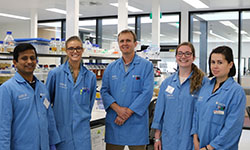 Charles Sturt University (CSU) research has uncovered new information about how two deadly viruses, Nipah and Hendra, replicate.
Charles Sturt University (CSU) research has uncovered new information about how two deadly viruses, Nipah and Hendra, replicate.
The research led by Professor Jade Forwood (pictured left) from the CSU School of Biomedical Sciences has been published today in the prestigious journal Nature Communications.
Hendra (HeV) and Nipah (NiV) are newly emerged zoonotic diseases, that use bats of the Pteropus genus as reservoir hosts but cause fatal infections in other animals and humans.
Professor Jade Forwood, who is also a member of the Graham Centre for Agricultural Innovation, said, "These viruses infect both animals and people and have a very high fatality rate.
"The Nipah virus is particularly a concern in Asia where people often live closely with animals, and there have been a number of outbreaks since 1999. The World Health Organisation (WHO) has identified an urgent need for research into the Nipah virus."
There have been a number of outbreaks of Nipah virus in Asia and the virus infects a wide range of animals and causes severe disease and death in people, making it a public health concern.
Hendra virus was first detected in Australia in 1994 and there have been more than 70 cases in horses since then. Seven people have also been infected with the virus from sick horses, with four deaths.
 The research made use of the Australian Synchrotron in Melbourne, part of the landmark research infrastructure of the Australian Nuclear Science and Technology Organisation (ANSTO).
The research made use of the Australian Synchrotron in Melbourne, part of the landmark research infrastructure of the Australian Nuclear Science and Technology Organisation (ANSTO).
Professor Forwood said, "Our research has examined how a particular protein in the Hendra and Nipah viruses, the W protein, can target and bind specifically with receptors within the host cell to mediate its delivery to the nucleus. The research also provides new insights into a range of important cellular and disease processes, including cancers, that are reliant on these receptors delivering proteins to the nucleus.
"This information is significant because if we can understand how and why this occurs we may be able to develop drugs to treat the virus or other diseases reliant on these pathways."
 The research team involved scientists from CSU, the Australian Synchrotron, the Center for Microbial Pathogenesis at Georgia State University in the United States, and La Trobe University.
The research team involved scientists from CSU, the Australian Synchrotron, the Center for Microbial Pathogenesis at Georgia State University in the United States, and La Trobe University.
Australian Synchrotron Beamline scientist, Dr David Aragao, a co-author of the paper, said that obtaining a clear motion picture of key biological process at the molecular level is often not available with current biomedical techniques.
"However, using X-ray crystallography from data collected on both MX1 and MX2 beamlines at the Australian Synchrotron, we were able to obtain (8) ‘photograph-like’ snapshots of the molecular process that allows the virus to replicate," Dr Aragao said.
 The paper, ‘Structural basis for importin alpha 3 specificity of W proteins in Hendra and Nipah viruses’ by Professor Forwood, Ms Kate Smith, Ms Sofiya Tsimbalyuk, Dr Megan Edwards, Ms Emily Cross, Dr Jyoti Batra, Dr Tatiana Soares da Costa, Dr David Aragao, and Professor Christopher Basler, will be available here: http://www.nature.com/ncomms
The paper, ‘Structural basis for importin alpha 3 specificity of W proteins in Hendra and Nipah viruses’ by Professor Forwood, Ms Kate Smith, Ms Sofiya Tsimbalyuk, Dr Megan Edwards, Ms Emily Cross, Dr Jyoti Batra, Dr Tatiana Soares da Costa, Dr David Aragao, and Professor Christopher Basler, will be available here: http://www.nature.com/ncomms






